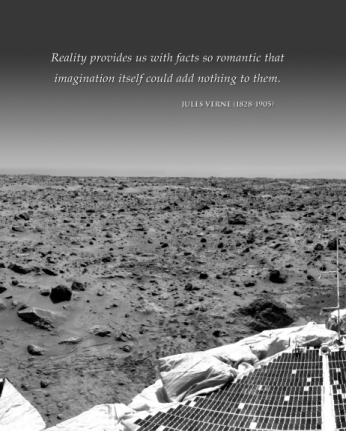
.
A century ago, belief that a civilization lived on Mars was so widespread that the term “Martian” became essentially synonymous with “alien.” Although occasional speculation about life on Mars goes far back into history, the craze began in 1877, when Italian astronomer Giovanni Schiaparelli reported seeing linear features across the surface of Mars through his telescope. He named these features canali, the Italian word for “channels.” English accounts mistranslated the term as “canals,” and coming amidst the excitement surrounding the recent opening of the Suez Canal (in 1869), Schiaparelli’s discovery soon inspired visions of artificial waterways built by a Martian civilization.
Schiaparelli himself remained skeptical of such claims, and it’s not clear whether he even thought the canali contained water. He may simply have been following a long-standing tradition adopted for the Moon, where visible features were referred to as bodies of water. But his work caught the imagination of a young Harvard graduate named Percival Lowell.
Lowell came from a wealthy and distinguished New England family. His brother Abbott became president of Harvard and his sister Amy was the well-known poet. After a few years as a businessman and as a traveler in the Far East, Percival Lowell turned to astronomy. Impassioned by his belief in the Martian canals and enabled by his wealth, Lowell commissioned an observatory (the Lowell Observatory) in Flagstaff, Arizona. Upon its completion in 1894, he set about making regular observations of Mars. In 1895, he published detailed maps of the canals, as well as a book expounding not only his belief that they were constructed by a Martian civilization but also his conclusions about the nature of that civilization. Because Lowell had correctly deduced that Mars was generally arid and had icy polar caps, he imagined that the canals were built to carry water from the poles to thirsty cities nearer the equator. (He was incorrect in assuming the polar caps to be water ice; they are largely carbon dioxide ice.) From there it was a short step to imagine the Martians as an old civilization on a dying planet, and the global network of canals convinced Lowell that they were citizens of a single, global nation. Such ideas provided the “scientific” basis for H. G. Wells’s The War of the Worlds, published in 1898.
The canal myth persisted for decades, despite the fact that Lowell’s canals never showed up clearly in photographs and other astronomers did not see them. Belief in Martians remained widespread enough to create a famous panic during Orson Welles’s 1938 radio broadcast of The War of the Worlds, when many people thought an invasion was actually under way. The debate about Martian canals and cities was not entirely put to rest until NASA’s first two spacecraft to Mars – the Mariner 4 flyby in 1965 and the Mariner 9 orbiter in 1971 – sent back images of a barren, cratered surface.
Today we can be quite certain that there is no great Martian civilization, and probably never has been. But the possibility of microbial life on Mars remains a hot topic in science. Moreover, several other worlds in our solar system now seem like possible homes to indigenous life. Thus we are led to mystery #10 on our list: Is there life elsewhere in our solar system?
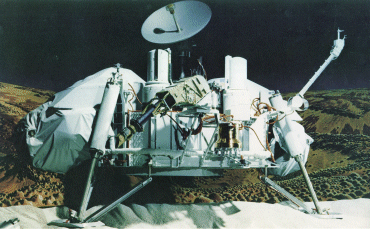
This photograph shows a working model of the Viking landers, identical to those that landed on Mars in 1976. It is on display at the National Air and Space Museum in Washington, D.C.
Mars is an appealing place to look for life, because it is the most Earth-like planet in the solar system, at least on the surface. Nevertheless, today’s Mars would not be a very comfortable place to visit: the atmosphere is far thinner than that on the top of Mount Everest, and no human could survive more than a few minutes without a pressurized spacesuit. The temperature is usually well below freezing, and there is no liquid water anywhere. And because the atmosphere contains only trace amounts of oxygen and hence essentially no ozone (which is a form of oxygen), the Sun’s deadly ultraviolet rays pass unhindered to the surface. Any Earth-like organism that left itself exposed would be quickly killed by this ultraviolet radiation.
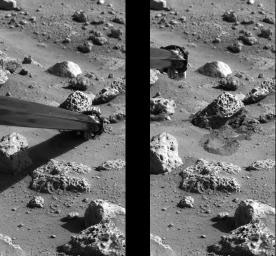
This pair of before and after photographs, transmitted back to Earth by the Viking 2 lander, shows where the robotic arm pushed away a small rock on the Martian surface.
Viking 1 and its twin, Viking 2, were each equipped to search for Martian life in a fairly simple way. (Each was also accompanied on its journey to Mars by a Viking orbiter, which studied Mars from above.) Like all planetary missions to date, the Viking spacecraft made only one-way journeys. Observations and experiments designed to search for life had to be planned before the spacecraft were launched, and were carried out robotically by the spacecraft on Mars.
The spacecraft then transmitted pictures and other scientific data from Mars back to Earth. The Viking landers could not move about the surface at all, but each lander had a robotic arm that it used to push small rocks aside and scoop up samples of Martian soil. A few simple, automated experiments then analyzed the soil, searching for organic compounds and signs of biological activity, such as respiration. Although the experiments did show some surprising results, planetary scientists soon explained these as chemical rather than biological reactions.
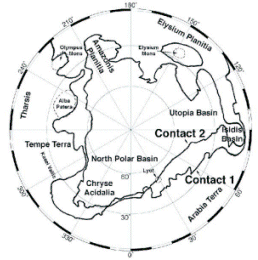
This projection shows the Northern Hemisphere of Mars, with the North Pole at the center. The black curves represent possible shorelines of an ancient Martian ocean.
Pathfinder, a simpler and considerably less expensive spacecraft than Viking, landed on Mars in a rather innovative way. A parachute slowed its descent through the Martian atmosphere, but it still hit the surface at crash-landing speed. To protect itself, Pathfinder deployed airbags on the way down, which completely encased the spacecraft components. These airbags allowed it to bounce along the surface until it finally came to rest. Over the next several months, Pathfinder surveyed the landing site with cameras and other on-board instruments. Sojourner, which had been stowed on Pathfinder for the journey from Earth, slowly roamed the neighborhood. (Sojourner was named for Sojourner Truth, an African American heroine of the Civil War era who traveled the nation advocating equal rights for women and blacks.) Although Sojourner could travel only a few meters from Pathfinder, this was enough to check the chemical composition of many nearby rocks. The results confirmed what scientists had suspected: the landing site, in the Ares Vallis region, is a vast, ancient floodplain. Rocks of many types lie jumbled together as they were deposited by the flood, and the departing waters left rocks stacked against each other in the same manner that floods do on Earth.
Pathfinder and Sojourner were designed more to test efficient and cheap new technologies than to search for life, but they marked the beginning of an ambitious invasion of Mars by spacecraft from Earth – and perhaps someday soon by human beings. As Earth and Mars orbit the Sun, the two planets are sometimes reasonably close (if 30 million miles can be called close) and other times much farther apart. When they are close, which happens roughly every two years, a journey to Mars takes about eight months with current technology.
NASA hopes to send two or more space probes to Mars at every one of these biennial opportunities over the next decade; however, the failure of both 1999 missions (the Mars Polar Lander and the Mars Climate Orbiter) may slow the parade somewhat while scientists and engineers figure out how to prevent similar losses in the future. Other nations, notably Japan and the member nations of the European Space Agency, also have plans for robotic missions to Mars. (The first Japanese mission to Mars, called Nozomi, was launched in 1998 but will not arrive until at least 2003, due to an engine misfiring shortly after launch.) The more sophisticated probes may carry rovers capable of journeying for many miles across the Martian surface in search of life.
Naturally, the search for life would be easier if we could bring a sample of Martian soil back to Earth, where we could subject it to analysis more detailed than is possible with automated probes that remain on Mars. NASA hopes to launch a sample-return mission to Mars as early as 2005, in which case we could have newly collected Martian rocks and soil in our hands as early as 2007 or 2008.
Surprisingly, that would not be our first sample of Mars, as scientists believe that a few meteorites may have a Martian origin. Almost all meteorites share common characteristics which tell us that they are either pieces of rock left over from the formation of our solar system or pieces of shattered asteroids. (Indeed, radioactive dating of these ancient meteorites is how we know that our solar system formed 4.6 billion years ago.) But a few meteorites have unusual compositions that suggest a different origin. These rare meteorites seem to be chunks of rock from the surface of the Moon and Mars. Based on what we know about the chemical composition of Mars from the Viking landers, thirteen of these meteorites (as of this writing) have compositions that are near perfect matches for what we expect in rocks from Mars.
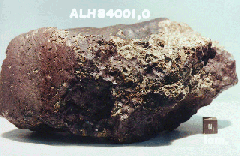
Meteorite ALH 84001 weighs a little less than 5 pounds and measures about 6 inches long by 4 inches by 3 inches. It is apparently a rock from Mars.
The globules found in ALH 84001 contain chemical evidence suggestive of life, including layered carbonate minerals and complex molecules (polycyclic aromatic hydrocarbons) – both of which are generally associated with life when found in Earth rocks. Even more intriguing, under high magnification the globules reveal eerily lifelike, rod-shaped structures. However, while some scientists suggest that these structures might be fossils of microscopic Martian life, others argue that all the so-called evidence for Martian life in ALH 84001 could have been produced by nonbiological processes. This extraordinary debate about whether we already have discovered evidence of life beyond Earth will undoubtedly continue as scientists subject ALH 84001 and other Martian meteorites to further scrutiny. Unfortunately, unless there is a surprising and major breakthrough, it is unlikely that the meteorites by themselves can provide definitive evidence of life. For that, we will have to rely on the planned armada of spacecraft bound for Mars.
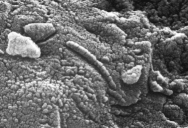
Some scientists believe that the rod-shaped structures seen in this microscopic view of a thin section from ALH 84001 are fossils of microbial Martian life, but most others are skeptical.
Until fairly recently, most scientists would have answered, “all life forms do.” But the past few decades have seen extraordinary discoveries about the abodes of life on Earth. Biologists have found microorganisms living deep inside rocks in the frozen deserts of Antarctica and inside rocks buried nearly a mile underground. Perhaps most important to the search for life beyond Earth, scientists have found teeming life near deep, undersea volcanic vents. This life does not in any way depend on sunlight, instead receiving all its chemical energy from the heat of the Earth itself. Moreover, genetic analysis of life-forms around the volcanic vents suggests that they may be more closely related to the common ancestor of all life on Earth than any other living organisms. Many biologists therefore believe that life may have first arisen around volcanic vents, with sunlight-dependent life coming only later. If so, then the water around undersea volcanoes might be the best place to find life in our solar system – and we know of at least one place beyond Earth where such volcanoes may be found.
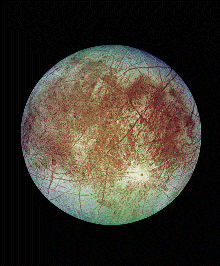
A global view of Europa shows a fractured crust nearly devoid of craters.
With a deep ocean and a source of energy in its undersea volcanoes, Europa may be even more likely to harbor life than Mars. Indeed, if biologists are correct in guessing that life on Earth first evolved near undersea volcanic vents, an absence of life on Europa may be more difficult to explain than its presence.
Not surprisingly, Europa is now a prime target for scientific exploration. NASA is currently developing plans for a Europa orbiter that could be launched as early as 2003 to reach Europa in 2006 or 2007. This mission would carry a radar instrument designed to establish whether or not Europa really has a subsurface ocean, and perhaps how much liquid water lies beneath the icy crust. If the existence of an ocean is verified, a follow-on mission would send a spacecraft to land on Europa, where it would use battery-generated heat to melt its way through the crust and into the ocean. There’s no telling what such a mission might find, from microbial life to creatures larger than whales.
Europa provides the clearest case to date for a subsurface ocean, but Ganymede and Callisto, two other moons of Jupiter, may also have such oceans. These worlds, too, have icy surfaces, but their larger numbers of craters shows that water flows occur less commonly, if at all. Nevertheless, it’s certainly worth looking for life on both of these moons as well. Imagine the irony if we found life on all three: there might be more inhabited worlds around the far-flung planet Jupiter than in the rest of the solar system combined.
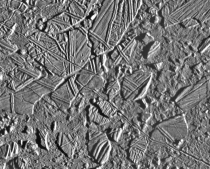
This close-up of Europa’s surface shows jumbled crust in which icebergs are apparently frozen in slush. (Photos taken from NASA’s Galileo spacecraft.)
Answers about Titan may be coming fairly soon, because a spacecraft called Cassini is scheduled to arrive there in 2004. Cassini was launched in 1997 and carries a radar instrument that should allow us to map Titan’s surface in detail. It also carries a probe called Huygens (named for the seventeenth-century astronomer who discovered Titan), which it will drop to the surface of Titan. Just in case, the probe is designed to float in liquid ethane.
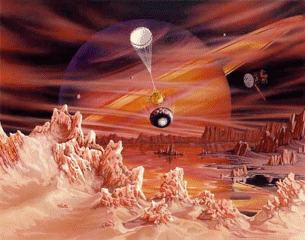
This is a photograph of part of Titan from Voyager 2. Note that it is completely enshrouded by its thick atmosphere. The artists’s conception
A more speculative idea suggests that life might exist on comets, which we know to contain large amounts of organic material. A few scientists have even suggested that life on Earth may have been brought here by a comet. If so, comets may have seeded life on many other worlds. Moreover, presence on Earth of meteorites from Mars tells us that planets occasionally exchange rocks dislodged by major impacts. The harsh conditions under which some life on Earth exists suggest that living organisms might survive such impacts and the long journey from one planet to another. In that case, life may have migrated among the planets just as various species spread among islands on floating debris. Life from Earth may have made its way to Mars – or vice versa. If we ever discover life on another world, we should be able to tell whether it shares a common origin with life on Earth by examining its set of genetic instructions.
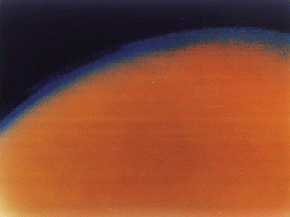
This photo hows what the surface might look like as the Huygens probe descends in 2004. Saturn and the Cassini orbiter are faintly visible through the atmosphere. (Artistic license has been taken to make the orbiter look big enough to be seen from the moon’s surface.)
All text on this site is protected by copyright law. © 2000, Jeff Bennett.
